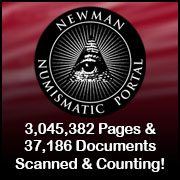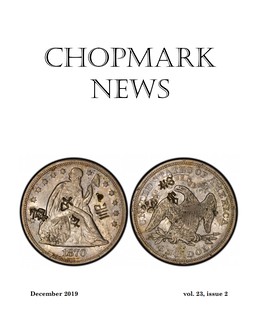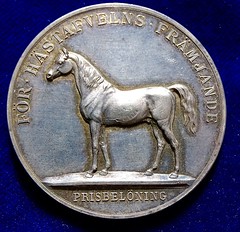
About UsThe Numismatic Bibliomania Society is a non-profit association devoted to the study and enjoyment of numismatic literature. For more information please see our web site at coinbooks.org SubscriptionsThose wishing to become new E-Sylum subscribers (or wishing to Unsubscribe) can go to the following web page link MembershipThere is a membership application available on the web site Membership Application To join, print the application and return it with your check to the address printed on the application. Print/Digital membership is $40 to addresses in the U.S., and $60 elsewhere. A digital-only membership is available for $25. For those without web access, write to: Charles Heck, Treasurer
AsylumFor Asylum mailing address changes and other membership questions, contact Chuck at this email address: treasurer@coinbooks.org SubmissionsTo submit items for publication in The E-Sylum, write to the Editor at this address: whomren@gmail.com BUY THE BOOK BEFORE THE COINSale Calendar
|
- WAYNE'S WORDS: THE E-SYLUM MARCH 11, 2020
- NBS BIBLIOTALK PODCAST INTERVIEWS GEORGE KOLBE
- KOLBE & FANNING U.S. CATALOGUE LIST
- SOLIDUS NUMISMATIC LITERATURE AUCTION 55
- NEW BOOK: HOBO NICKEL GUIDEBOOK 5TH PRINTING
- NEW BOOK: JEWISH-AMERICAN HALL OF FAME MEDALS
- NEW BOOK: COLLECTING VINTAGE COIN BOARDS
- PERIODICAL: CHOPMARK NEWS DECEMBER 2019
- DEFINING “GREATNESS” AMONG MODERN WORLD COINS
- BOOK REVIEW: DIRECTORY OF CIRCULATING COINS 3RD
- BOWERS & RUDDY 1980 OLYMPIC COINAGE PROPOSAL
- NANCY GREEN (1947-2020)
- THE PHILADELPHIA MINT'S BICENTENNIAL EXHIBIT
- BONDED, MATED AND RETAINED ERRORS
- NOTES FROM E-SYLUM READERS: MARCH 8, 2020
- FAKE NEWS: THE QUATLOO OF TRISKELION
- VOCABULARY TERM: JANVIER PANTOGRAPH
- HENRY C. KENDRICK (1828-1894)
- MYSTERY COIN BOARD BINDER
- THE HEALTH OF THE HOBBY, 2020
- DAVISSON'S AUCTION 39 CLOSES APRIL 1, 2020
- NUMISMAGRAM MEDAL SELECTIONS: MARCH 2020
- STACK'S BOWERS OFFERS BERG-GARRETT 1804 DOLLAR
- 1865 SERIAL NUMBER 1 NATIONAL BANK NOTE SHEET
- YEMEN'S RIVAL BANKNOTES
- BANKNOTE HANDLERS CORONAVIRUS CAUTIONS
- ARTIST ANDREY AVGUST REIMAGINES U.S. BANKNOTES
- FEATURED WEB SITE: ROYAL HAWAIIAN MINT
Click here to access the complete archive
To comment or submit articles, reply to whomren@gmail.com
Content presented in The E-Sylum is not necessarily researched or independently fact-checked, and views expressed do not necessarily represent those of the Numismatic Bibliomania Society.
WAYNE'S WORDS: THE E-SYLUM MARCH 11, 2020
 This week we open with a new NBS podcast episode, a fixed price list, a numismatic literature auction, three new books, a book review and more, including a rare piece of ephemera on the
Newman Numismatic Portal.
This week we open with a new NBS podcast episode, a fixed price list, a numismatic literature auction, three new books, a book review and more, including a rare piece of ephemera on the
Newman Numismatic Portal.
Other topics this week include chopmarks, ANA librarian Nancy Green, the Philadelphia Mint's bicentennial exhibit, the Janvier pantograph, Davisson's Auction 39, medal selections from Numismagram, the Berg-Garrett 1804 Dollar, Yemen's rival banknotes, and the Royal Hawaiian Mint.
To learn more about the numismatic book business since the 1960s, medals of Holland, Hobo Nickels, collecting coin boards, bonded, mated and retained errors, the Feminine Virtue medal, and the Quatloo of Triskelion, read on. Have a great week, everyone!
Wayne Homren
Editor, The E-Sylum
NBS BIBLIOTALK PODCAST INTERVIEWS GEORGE KOLBE
Thje latest episode of the Numismatic Bibliomania Society podcast is now available for listening. Check it out! It's on the NBS web site but also available on Apple Podcasts, Google Podcasts, Spotify, and elsewhere. -Editor
NBS Bibliotalk Podcast Interviews George Kolbe
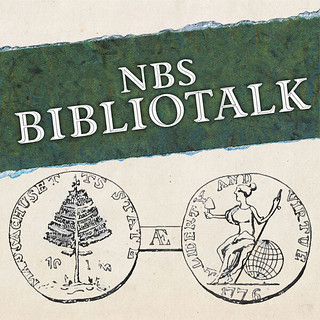 A new episode of the quarterly NBS podcast, “300
Linear Feet of Books” is now posted on the NBS home page. Lianna Spurrier interviews George Kolbe, covering the history of the numismatic book business since the 1960s, as well as the formation of
the Numismatic Bibliomania Society. Kolbe reveals his current collecting interest (hint, it might be related to books) and talks about highlights from various libraries. This is a wide-ranging and
engaging discussion, perfect to fill your commute. Spurrier concludes the podcast with a review of the recent Whitman publication, 100 Greatest Modern World Coins.
A new episode of the quarterly NBS podcast, “300
Linear Feet of Books” is now posted on the NBS home page. Lianna Spurrier interviews George Kolbe, covering the history of the numismatic book business since the 1960s, as well as the formation of
the Numismatic Bibliomania Society. Kolbe reveals his current collecting interest (hint, it might be related to books) and talks about highlights from various libraries. This is a wide-ranging and
engaging discussion, perfect to fill your commute. Spurrier concludes the podcast with a review of the recent Whitman publication, 100 Greatest Modern World Coins.
To listen to the podcast, go to the NBS web site:
https://www.coinbooks.org/
KOLBE & FANNING U.S. CATALOGUE LIST
Check out the new fixed price list from Kolbe & Fanning; it's a nice opportunity to build or fill in a collection of classic U.S. coin auction catalogues. -Editor
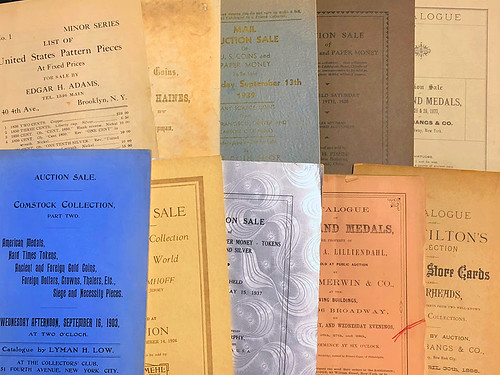
Kolbe & Fanning have put together a fixed price list of nearly 600 U.S. numismatic sale catalogues dated through 1940. By “old school,” we mean that it’s a pretty basic listing, with few comments on condition or contents. Many of these catalogues are scarce, and often include hand-pricing or printed prices realized lists. The vast majority of them are inexpensive, though we have included a few (far more extensively described) gems to give the listing some spice. We hope you enjoy it.
To make the offering even more attractive, all items priced at under $100 are subject to a discount that varies from 10% to 30% based on total order value of $100 or more: see the catalogue for details. Orders should be placed via email at orders@numislit.com.
Kolbe & Fanning stock over 1000 retail titles on our website at numislit.com. Users can browse by category or search by title, as well as sign up to receive email notifications when new titles are added to particular categories. We're here to help you find what you need.
SOLIDUS NUMISMATIC LITERATURE AUCTION 55
The Solidus firm of Munich, Germany is offering a sale of numismatic literature closing March 29, 2020. Here are a few selected lots. -Editor
Lot 12: Medals of Holland
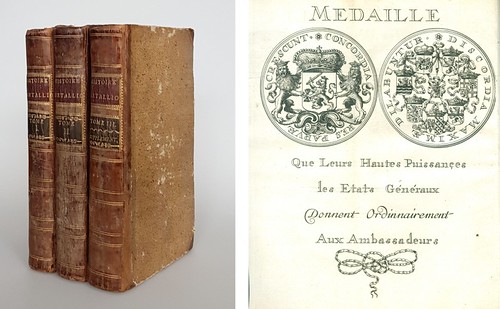
Histoire métallique de la republique de Hollande. In addition: Supplément à l'histoire métallique de la république de Hollande, dans lequel, outre plusieurs médailles qu'on a ajoutés, depuis la naissance de la République, jusqu'à la fin de l'année 1689, on verra toutes celles qui ont été frappées sur l'expédition de SA le Prince d'Orange, Roi d'Angleterre & sur son couronnement. Et les tombeaux des personnages qui ont sacrifié leur vie pour la Hollande leur Patrie. Amsterdam 1688-1690. Avertissement, 160 p. With numerous copper text; Pp. 160-315 with numerous copper text, remarques, table; 16 p. Avertissement, 256 p. With numerous copper text, 56 p., Table. Uniform old half leather, bumped.
Lot 16: Biblical numismatics
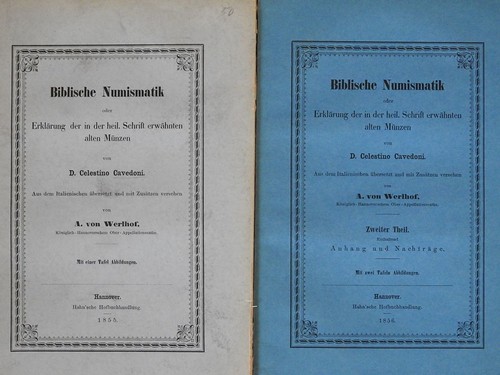
Monographs. Bibliophile works. Cavedoni, DC / Werlhof, A. von.
Biblical numismatics or explanation of the holy. Scripture mentioned old coins, in 2 parts (complete). Hanover 1855/1856. IX, 163 pages, 1 p.; XXX, 76 p. 2 Tfn. Paperback, partly untrimmed, title page in volume 1 almost loose, water stains in volume 2.
Lot 20: Nummorum
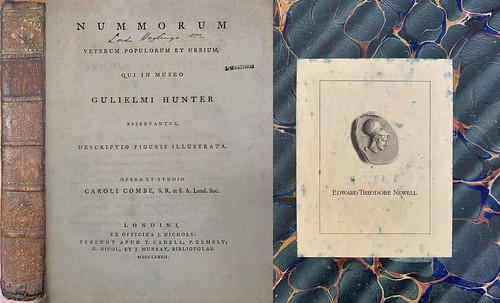
Nummorum veterum populorum et urbium, qui in museo G. Hunter asservantur. London 1782. XI, 354 pages, 1 sheet, 68 p. Whole leather, the plates with handwritten additions in the upper margin, partly somewhat foxed.
Very rare work. With bookplate 'Edward Theodore Newell'. With owner's stamp and owner's name.
Lot 44: Introduction to the science of medals or coins
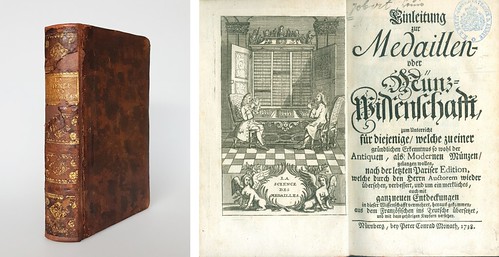
Monographs. Bibliophile works. Jobert, P.
Introduction to the science of medals or coins, to lessons for those who want to gain a thorough understanding of antiquities as modern coins. Nuremberg 1738. Frontispiece, 28, 488 p., Register (24 p.), 11 folds. Whole leather, bumped.
With owner's stamp.
For more information, or to bid, see:
Literature auction 55 - 29.03.2020 14:00
(https://solidus-numismatik.auex.de/Auktion/Onlinekatalog?intAuktionsId=825)
https://www.sixbid.com/de/solidus-numismatik/7171
https://www.solidus-numismatik.de/en/auctions/
To read a CoinsWeekly article on the sale, see:
Numismatic Literature at Solidus (https://coinsweekly.com/numismatic-literature-at-solidus/)
NEW BOOK: HOBO NICKEL GUIDEBOOK 5TH PRINTING
From the Spring 2020 issue of Bo Tales, the official publication of the Original Hobo Nickel Society, Inc:
"A new 5th edition printing of the Hobo Nickel Guidebook by Stephen P. Alpert was authorized by the OHNS Board at the January F.U.N. Convention and is now available for sale. Price for OHNS members is $28 ($35 for non-members). Please contact Art DelFavero..."
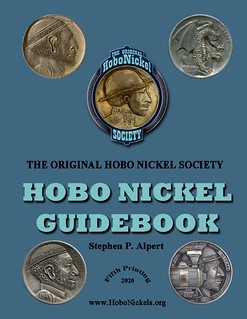 The Original Hobo Nickel Society has just
reprinted its Hobo Nickel Guidebook authored by Stephen P. Alpert, which presents an up to date guide to hobo nickels and their values. Both classic old hobo nickels and modern creations are
presented, with information on how to tell them apart. Over 700 enlarged photographs of hobo nickels are illustrated in the 126 page spiral-wire-bound book.
The Original Hobo Nickel Society has just
reprinted its Hobo Nickel Guidebook authored by Stephen P. Alpert, which presents an up to date guide to hobo nickels and their values. Both classic old hobo nickels and modern creations are
presented, with information on how to tell them apart. Over 700 enlarged photographs of hobo nickels are illustrated in the 126 page spiral-wire-bound book.
The purpose, methods of creation, and the components of hobo nickels are discussed. The most common type of hobo nickel is the standard design depicting a bearded man wearing a derby. Other subjects include ethnic figures, hatless men, soldiers, women, famous people, and altered buffaloes (changed into a man or a different animal). All these are discussed and illustrated in the book.
The OHNS Quality Designation scale for hobo nickels (Crude to Superior) is explained, and examples and general values for each are given, along with the factors affecting a hobo nickel's desirability.
An Artist Gallery chapter covers dozens of old, nicknamed, and modern hobo nickel artists with examples of their work. And an Auction Photo Gallery illustrates hundreds of hobo nickels sold in past OHNS auctions, along with the hammer price of each. This is valuable information as the most desirable hobo nickels (both old and modern) sell for $1,000.00 to $2,000.00 apiece.
Other chapters cover cast fakes, hobo tokens, and other similarly altered coins, both U.S. and foreign.
Art "Cinco" DelFavero may be reached at 41562 Cornell Dr., Novi, MI 48377-1559. Email: arturodelfavero1@gmail.com . Please make checks payable to ORIGINAL HOBO NICKEL SOCIETY.
NOTE: the below-linked web page has not been been updated as of this writing; the pricing and ordering information shown there may be obsolete. This is a new printing with minor changes from the previous edition. -Editor
For more information on the book, see:
http://www.hobonickels.org/guidbook.htm
For more information on OHNS, or to join, see:
http://www.hobonickels.org/

NEW BOOK: JEWISH-AMERICAN HALL OF FAME MEDALS
A new, improved version of Mel Wacks' book on Jewish-American Hall of Fame medals is available at the Newman Numismatic Portal, and for the first time, in print as well. -Editor
“Medals of the Jewish-American Hall of Fame 1969-2019” Published
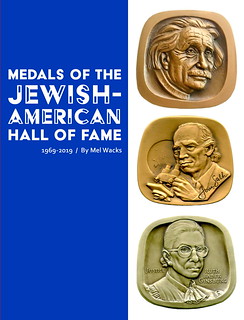 Jewish-American Hall of Fame
medals issued from 1969 to 2019 have found homes in collections, museums, etc. around the world ? becoming the longest continuing series of non-government art medals currently being issued in the
world. Now, for the first time, biographies of more than 50 Jewish-American Hall of Fame inductees have been published, along with their portrait medals created by leading medalists ? many of whom
have won the prestigious Numismatic Art Award for Excellence in Medallic Sculpture (presented by the American Numismatic Association), and the American Numismatic Society's J. Sanford Saltus
Award for Outstanding Achievement in the Art of the Medal.
Jewish-American Hall of Fame
medals issued from 1969 to 2019 have found homes in collections, museums, etc. around the world ? becoming the longest continuing series of non-government art medals currently being issued in the
world. Now, for the first time, biographies of more than 50 Jewish-American Hall of Fame inductees have been published, along with their portrait medals created by leading medalists ? many of whom
have won the prestigious Numismatic Art Award for Excellence in Medallic Sculpture (presented by the American Numismatic Association), and the American Numismatic Society's J. Sanford Saltus
Award for Outstanding Achievement in the Art of the Medal.
This book, written by Mel Wacks, founder of the Jewish-American Hall of Fame, also includes back stories of the medals ? including correspondence with the medalists and preliminary art work ? adding to the appreciation of the final works of art. Mintages and mints are indicated for the benefit of collectors. In addition, the reader will find pictures and mintage data for over three dozen special medals commissioned by the Jewish- American Hall of Fame.
On the back cover, noted medal collector and scholar Donald Scarinci writes: "For those who are interested in American history, culture, art and science, the Jewish-American Hall of Fame medals form a gallery of great Americans." Accordingly, the book features biographies about honorees such as physicist Albert Einstein, Supreme Court Justice Ruth Bader Ginsburg, baseball hall of famer Hank Greenberg, magician Houdini, Israel Prime Minister Golda Meir, newspaper publisher Joseph Pulitzer, immunologist Jonas Salk, patriot Haym Salomon, entertainer Barbra Streisand, and many more.
Just as you don't have to own a Rembrandt to enjoy an art museum, you don't have to be a medal collector to appreciate this handsome and informative volume. The extensively illustrated, large 8 1/2 x 11” 150 page book was designed by Lianna Spurrier under the sponsorship of the Newman Numismatic Portal. It is available for $35 postpaid on Amazon or an autographed copy can be ordered by calling the author at 818-225-1348.
To read the book on the Newman Portal, see:
Jewish-American Hall Of Fame Medals, 1969-2019 (https://nnp.wustl.edu/library/book/556056)
To order your own copy, see:
Medals of the Jewish-American Hall of Fame 1969-2019
(https://www.amazon.com/Medals-Jewish-American-Hall-Fame-1969-2019/dp/1792329482/)
To read the earlier E-Sylum article, see:
NEW BOOK: JEWISH-AMERICAN HALL OF FAME MEDALS (https://www.coinbooks.org/v21/esylum_v21n43a03.html)
NEW BOOK: COLLECTING VINTAGE COIN BOARDS
In the Spring 2020 issue of his Coin Board News, author David Lange announced a new book by Donald Kocken. -Editor
 Fellow coin board and album collector Donald Kocken has been
featured in Coin Board News several times, and now he’s sharing his collecting experience in a charming little book. Titled Collecting Vintage Coin Boards, Albums, and Folders, it is 49
pages spiral bound and illustrated in full color.
Fellow coin board and album collector Donald Kocken has been
featured in Coin Board News several times, and now he’s sharing his collecting experience in a charming little book. Titled Collecting Vintage Coin Boards, Albums, and Folders, it is 49
pages spiral bound and illustrated in full color.
While all of these items will be featured in greater detail in later volumes of my own book series, this guide serves as a great introduction to what’s out there to collect. Don’s book is priced at just $10, plus $4.40 for shipping and handling. Contact him at 920-337-6509.
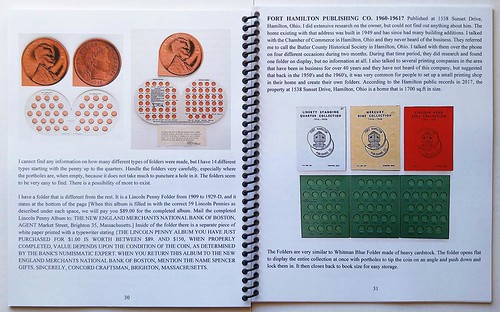
Nice! We'll look forward to this. -Editor
PERIODICAL: CHOPMARK NEWS DECEMBER 2019
The latest issue of Chopmark news, the newsletter of the Chopmark Collectors Club has been published. Editor Colin Gullberg has pulled togehter a whopping 50-page issue. Here's the Table of Contents. -Editor
New Members
eBay Sales
Club News
Meet our Members: Tomás Garcia Ferreiro
Coins from the Tomás Garcia Ferreiro Collection
Coins from Our Members’ Collections
Notes on Spanish Eight Reales and Chinese Chops By: F.S. Ballesta
Chopmarked Chinese Banknotes By: C. Cheung
Chopping Charles to Pieces or The Four Horsemen of the Chop-pocalypse, Part 2 By: M. Benvenuto
Interview: Stephen Tai
Coins from the Stephen Tai Collection
I think banknote collectors will find the Chopmarked Chinese Banknotes article by: C. Cheung very useful. For information about the club, contact Colin Gullberg at chopmarknews@gmail.com . -Editor
DEFINING “GREATNESS” AMONG MODERN WORLD COINS
Dennis Tucker of Whitman Publishing passed along this great article by the authors of the upcoming book 100 Greatest Modern World Coins about their criteria for including and ranking the chosen coins. -Editor
Defining “Greatness” Among Modern World Coins
by Charles Morgan and Hubert Walker
In March 2020 Whitman Publishing will release 100 Greatest Modern World Coins, by numismatists Charles Morgan and Hubert Walker. The 168-page coffee-table hardcover will be available from booksellers and hobby shops nationwide, and online (including at www.Whitman.com). Here, the book’s authors address two central questions of their manuscript: What makes a modern coin “great” . . . and why do great coins matter?
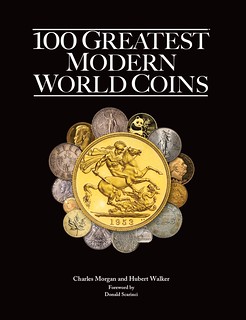 When it comes to coins, how does one
define greatness? This is a daunting question and one posed to generations of collectors and numismatic researchers. As it pertains to Whitman Publishing’s library of “100 Greatest” books, we applied
a number of criteria as we wrote our volume 100 Greatest Modern World Coins.
When it comes to coins, how does one
define greatness? This is a daunting question and one posed to generations of collectors and numismatic researchers. As it pertains to Whitman Publishing’s library of “100 Greatest” books, we applied
a number of criteria as we wrote our volume 100 Greatest Modern World Coins.
In the very first numismatic book in the line, 100 Greatest U.S. Coins, authors Jeff Garrett and Ron Guth outlined six factors: rarity, value, quality, popularity, beauty, and history. Given that Garrett and Guth were writing about a finite set of homogeneous U.S. coin issues, the over-emphasis of any one of these factors (save perhaps beauty) might lead to a rather uninteresting book.
Fortunately for all of us, in the first (and each subsequent) edition, this pair of top-tier numismatic researchers found a successful mix that works great for the U.S. coin series. Their books have sparked many lively discussions among the hobby faithful.
When it came to developing our own criteria for 100 Greatest Modern World Coins, we had to consider that the sweep of twentieth-century world-coin production was far more complex than an expert survey of the 100 greatest U.S. coin issues, nearly all of which have years of documented price performance and reasonably familiar back stories. Many rare world coins struck in the past 120 years are not well known outside of their issuing countries. Exploring historic auction data for the sale of these coins often requires specialist knowledge and years of market participation. Furthermore, as a collector steeped in American culture, one must be careful not to overemphasize Western aesthetics concerning art produced by other cultures. It’s a delicate dance, to be sure, but one we took a tremendous amount of care to execute as fairly as possible.
To us, compiling a list of 100 coins was more a matter of informed compromise.
When we set out to make our selections, we started by looking at the coinage output of every country around the globe spanning the past 120 years. We started with the year 1901, not because a valid case couldn’t be made that “modern coinage” started decades, or even a century or more, before, but because we felt the twentieth century was such a consequential period for numismatics that the coins of this century deserved to be considered among their peers. From a numismatic perspective, we consider this period to be an essential area of study to understand the present and future role of coins in society. Over the course of 100 coins, we embarked on an effort to tell that story.
To choose the coins on our list, we opted to take into consideration the following criteria.
Rarity. Generally speaking, coins are struck to be instruments of commerce that trade freely in exchange for goods and services, and, in order to achieve this goal, should not be rare. But there are instances where coins are struck in very limited numbers.
Among our selections, you will find coins struck for kings and queens; coins struck in limited numbers as presentation pieces for important members of government; pattern coins accidentally released into circulation; Proof issues struck in lower numbers than their circulation-strike counterparts; and coins that, for whatever reason, have had most of their mintages lost to time.
Rarity is an important factor that affects a coin’s numismatic value, but it is not the sole indicator of it.
Innovation. Over the course of the twentieth century, mints around the world introduced a number of important innovations that changed the global landscape of coins. Some of these creations were technical and involved processes and alloys used to strike coins. Some were artistic and introduced bold new aesthetics for coin design that paved the way for a global reimagining of the art form. Other innovations were driven by necessity or the needs of the market, such as long-overdue coinage reforms or the introduction of bullion coins as investment instruments.
The twentieth century introduced enormous challenges to the continued utility of coins as a circulating medium. Every step of the way, the world’s coin producers, both big and small, rose to the challenge and secured a viable place for coinage.
Coin Sets. Some of the greatest coins of the century need to be viewed in a broader context. Not every entry in our 100 Greatest Modern World Coins is an individual coin. In certain instances we study sets of coins. These sets may include one or more coins that, if considered individually, are sufficiently important to be included on our list. Other entries are known to collectors primarily as sets and it would be inconceivable to talk about one coin without discussing the others. Our goal was to valorize as many of the highlights of twentieth-century world coinage as possible, and in doing this we’ve included a fair number of sets.
Oddities and Emergency Issues. Human beings are amazing and resilient, and some of the most fascinating numismatic stories to unfold in the twentieth century center around coins that are a little off the beaten path. Some are limited-run vanity issues projecting the power and prestige of failed kings and despots, issued on the cusp of their overthrow, while others are crudely made pieces of emergency money issued by revolutionaries or by desperate people whose “revolutionary” idea was to survive no matter the cost. If holding a coin is like holding history in your hands, then coins struck in these ironic, unusual, and desperate circumstances tell us something about human nature and have an intrinsic greatness that is hard to ignore.
Auction Data and Market Values. This book presented an interesting challenge: How does one weigh an entire range of factors relating to modern world-coin issues and organize the coins so that the broadest survey is possible and auction data, certified-coin populations, and collector popularity aren’t overemphasized? We made every effort to review a variety of auction sources, historical records, and market-maker insights about the coins presented in 100 Greatest Modern World Coins. But we know that not every auction for every world coin included (or excluded) has been taken into consideration.
We provide certain auction data and market values for general interest, but we do not want readers to get the mistaken impression that every modern world coin that has ever sold for a significant sum of money was automatically included in our selection. Conversely, some of the coins on our list are readily available to collectors and hardly considered rare at all. If you use 100 Greatest Modern Coins to make purchasing decisions about rare and valuable coins, know that our ranking system is an opinion and should not outweigh your due diligence and appreciation of a piece. Lists are conversation starters and not the final word. The beauty of this is that the numismatic hobby is forever evolving and there is no shortage of stories to tell.
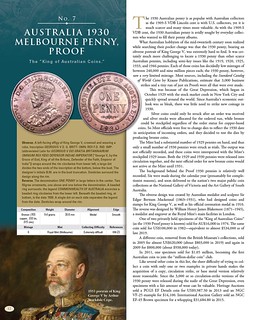
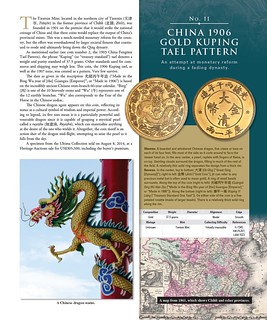
Why Do Great Coins Matter?
Many of the entries in 100 Greatest Modern World Coins fall outside the financial means of most collectors, and some pieces are so rare that the only known examples are held in museums or institutional collections. Others are so seldom encountered that it may take generations for an example to come to market. That’s okay. More important than owning one of the world’s greatest coins is the enrichment that comes from knowing its story and relating this information to the pursuit of other coins of its type, of the period, or of its issuing country.
The rarest of the rare coins that we consider the greatest are truly landmarks on the numismatic skyline.
Other great coins might be expensive but approachable, or not very expensive at all. A few of the coins on our list may be available for a small premium over current market value—or even a small premium over face value. Regardless of cost or even the public’s general perception of them, these greatest world coins have an important story to tell . . . but then, so do great coins, so do good coins, and so do average coins. No matter the scope or scale of your collection, the coins you select have stories. Every coin ever struck plays some role in making coin collecting a dynamic hobby. It is our hope that in reading our book, 100 Greatest Modern World Coins, you find yourself inspired to discover these stories and propel forward our hobby community’s appreciation for coins both great and ordinary.
100 Greatest Modern World Coins
By Charles Morgan and Hubert Walker; foreword by Donald Scarinci
ISBN 0794846335
Hardcover, coffee-table (10 x 12 inches); 168 pages; full color; retail $29.95 U.S.
About the Authors
Charles Morgan is an award-winning numismatic writer, industry analyst, and editor of one of the hobby’s most visited online publications, CoinWeek.com. At CoinWeek, he has written about and covered
the entire gamut of numismatic topics. As the host of the CoinWeek Podcast, Morgan has dug deeper into the history of numismatics with some of the hobby’s leading personalities.
His main areas of collecting interest are numismatic literature and the coins and medals of the Food and Agriculture Organization (FAO) of the United Nations. He also collects U.S. coins, classic films, and comic books.
Morgan studied English at Susquehanna University and the University of Virginia and served in the U.S. Army as a Russian linguist. He lives in Virginia with his wife, two children, and a very temperamental Maine Coon cat.
Hubert Walker is the assistant editor of CoinWeek.com and along with Charles has written numerous award-winning articles and columns, both online and in print. He studied English at the University of Virginia, though he is also keen on history, music, and art. Hubert currently resides in Virginia; his cat does not.
To read the earlier E-Sylum articles, see:
NEW BOOK: 100 GREATEST MODERN WORLD COINS (https://www.coinbooks.org/v22/esylum_v22n52a02.html)
BOOK REVIEW: 100 GREATEST MODERN WORLD COINS (https://www.coinbooks.org/v23/esylum_v23n03a04.html)
BOOK REVIEW: DIRECTORY OF CIRCULATING COINS 3RD
Jeff Starck of Coin World published a review of the new edition of the Directory of Circulating Coins. Here's an excerpt. E-Sylum reader Pabitra Saha provided information and images for the book. -Editor
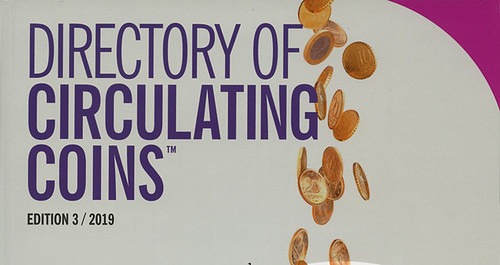
Currency News publishes Directory of Circulating Coins, published in its third edition in late 2019, following a first edition in 2014 and second edition in 2016.
The latest book reflects significant change since the second edition.
Since 2016, one or more coins were either withdrawn or ceased production in 12 countries. However, the same number of countries introduced higher denomination coins (both scenarios don’t necessarily apply to the same countries).
In addition, since the second edition, two countries have reintroduced or issued coins for the first time, and 18 countries changed their whole series of coin designs.
Though demand for coins has decreased 20 percent since the second edition, the number of coins in circulation has increased, according to a white paper by John Winchcombe that was published by Reconnaissance International, parent company to Currency News.
It is coins at the higher end that are being hoarded as a store of value, according to Winchcombe, just as bank notes act as a store of value.
Recirculation of coins is a constant challenge for issuing authorities and mints. The Dutch National Bank believes that 60 percent of coins are used only once, according to Winchcombe, who said, “If this could be changed, the savings would be significant.”
To read the complete article, see:
Book explores present circulating coinage demands
(https://www.coinworld.com/news/precious-metals/book-explores-present-circulating-coinage-demands)
To read the earlier E-Sylum article, see:
NEW BOOK: DIRECTORY OF CIRCULATING COINS 3RD ED. (https://www.coinbooks.org/v22/esylum_v22n30a03.html)

BOWERS & RUDDY 1980 OLYMPIC COINAGE PROPOSAL
The latest addition to the Newman Numismatic Portal is a 1980 Olympic Coinage Proposal from the Bowers & Ruddy firm. . Project Coordinator Len Augsburger provided the following report. -Editor
Bowers & Ruddy Proposal for 1980 Olympic Coinage
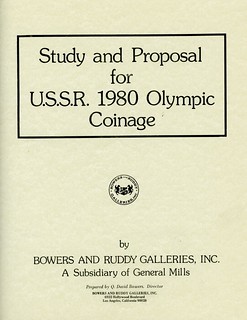 From Q. David Bowers comes a
fascinating item recently added to Newman Portal, a coinage proposal for the 1980 Moscow Olympics prepared by the Bowers & Ruddy rare coin firm in 1975. The proposal was submitted to
Vneshtorgbank, a Russian bank with specialty in foreign trade, and suggested that Bowers and Ruddy be appointed director of an international consortium to produce and market the pieces.
From Q. David Bowers comes a
fascinating item recently added to Newman Portal, a coinage proposal for the 1980 Moscow Olympics prepared by the Bowers & Ruddy rare coin firm in 1975. The proposal was submitted to
Vneshtorgbank, a Russian bank with specialty in foreign trade, and suggested that Bowers and Ruddy be appointed director of an international consortium to produce and market the pieces.
Bowers & Ruddy was well positioned to take a leadership role and made a number of suggestions, such as increased production of silver and nickel coins, which could be manufactured with greater profit margins than gold pieces. Mintages of the order of a million coins were suggested, with a total market opportunity of $150 million. The proposal came to naught as the pieces were ultimately struck in the Leningrad (St. Petersburg) and Moscow Mints, and the story of the U.S. boycott of the 1980 Games is well-known.
Link to Bowers & Ruddy 1980 Olympic coinage proposal on Newman Portal:
https://nnp.wustl.edu/library/archivedetail/536113?Year=1975&take=50
NANCY GREEN (1947-2020)
Former American Numismatic Association librarian Nancy Green has passed. -Editor
Tom DeLorey writes:
"My friend and former colleague at the ANA Nancy Green has passed away. One of the great people in this hobby."
Ken Bressett confirms:
"Yes, it was our beloved Nancy Green, the former A.N.A. librarian, who died last week. I heard the news directly from her son Andy. She had been in declining health for some time, however it was a sudden aneurysm that took her life. Andy immediately flew home from Australia and quickly let some of her closest friends know about the misfortune.
"Nancy lived in Colorado Springs for many years, was a long-time member of local coin clubs, and beloved by all. Her numismatic specialty was collecting artistic medals. For many years she served as Librarian for the A.N.A. before retiring and moving to Pagosa Springs, CO. After that she only visited here occasionally, but continued to have an interest in the A.N.A. and to visit her many friends.
"Her dedication and contributions to the hobby are known widespread, and she will be long remembered and honored for all she did to make this world a bit brighter and better for all who knew her. I have no information yet about funeral arrangements or a memorial. A.N.A. is planning to run her obituary in the May issue of The Numismatist."
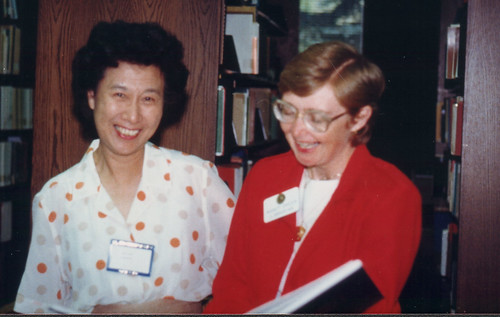
Lynn Chen & Nancy Green - July 1988
Dave Lange writes:
"Nancy was a charming and gracious person whose enthusiasm for her work was quite infectious. It was always a highlight seeing her during my many excursions to the ANA Summer Seminar. When she announced her retirement it seemed that the [now] Manley Library would never be able to carry on, yet I've found that everyone who has held the position of Library Director seems to possess the same intrinsic pleasure in that role. We are blessed to have known Nancy, as well as her colleagues.
"Here's a photo I took during the 1988 ANA Summer Seminar. It shows Nancy with her eventual successor, Lynn Chen."
"Nancy was born in northern Minnesota, near the Canadian border. I used to tease her that she had a a Canadian accent. She came to Colorado Springs with her first husband, John Stith, who was transferred there by the Air Force. John later published several science fiction titles. Nancy collected medals of Lea Ahlborn because of her Swedish heritage."
I added an image of a Lea Ahlborn medal from Wikipedia. Ken Bressett provided an address where friends may send condolences to her family. Write to me if you'd like to have that.
Nancy was a peach - always helpful and cheerful, she was a great guide for me as a budding numismatic bibliophile. -Editor
THE PHILADELPHIA MINT'S BICENTENNIAL EXHIBIT
George Cuhaj attended the Philadelphia Mint's Bicentennial Exhibit of the Eliasberg collection, which was discussed in Harvey Stack's article last week. He kindly passed along these photos. Thanks! -Editor
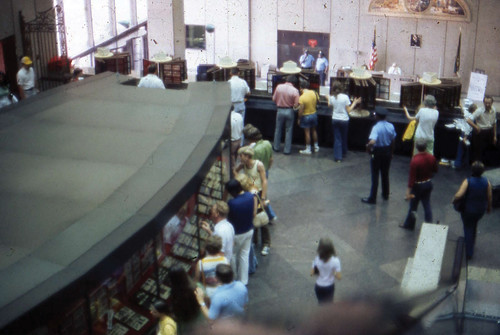
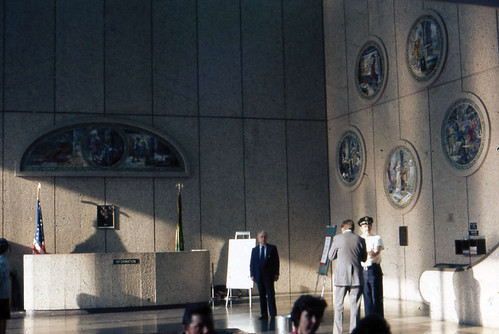
George also has this photo of an exhibit of the bicentennical quarter design, perhaps from a 1975 trip to Philadelphia. Love the plaster! -Editor
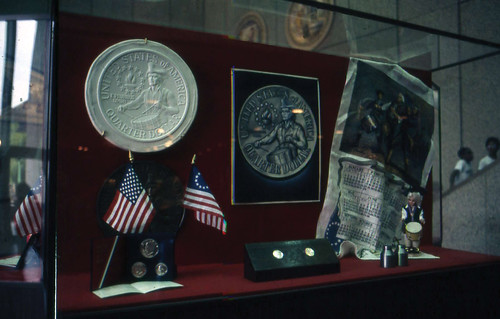
To read the earlier E-Sylum article, see:
HARVEY STACK'S NUMISMATIC FAMILY, PART 64 (https://www.coinbooks.org/v23/esylum_v23n09a15.html)
BONDED, MATED AND RETAINED ERRORS
Jonathan Brecher responded with some great examples of "impressed errors" and "strike-throughs". -Editor
For your question about strike-throughs, the magic word is "retained".
Retained wires and bristles and other wire-like-things are not exactly common but certainly obtainable. Retained identifiable other things are much rarer.
Actually, there are a couple of other good terms. One is "bonded" and one is "mated"
The "retained" term is usually used when you have something smaller than coin-sized struck into a coin.
The "bonded" term is usually used when you have two items of similar size struck together and there's no point arguing about which is struck into which.
The "mated" term is used for two pieces that were struck together and didn't stick, but are still both available. There are some jaw-droppers in this category, for example:
Here are a few examples Jonathan found. Thanks! -Editor
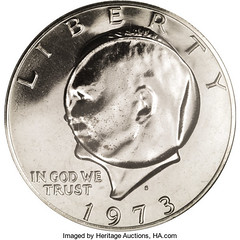
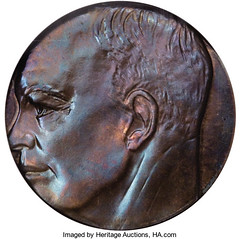
1973-S $1 Eisenhower Dollar--Indented by 1.73 gm Planchet, Mated Pair--PR67 and PR67 RB NGC. When the planchet for this particular proof Eisenhower dollar entered the press, a small copper-based planchet also entered the striking zone between the larger flan and the obverse die. The two resulting pieces, both the indented Eisenhower dollar and the uniface copper-based planchet, are offered here as a mated pair.
The 1973-S Eisenhower Dollar, PR67 offers gleaming fields and excellent preservation in general with minimal patina. A circular indent (from the piece listed below) obscures the vast majority of Eisenhower's head. Interestingly, the reverse is essentially unaffected.
The Uniface Foreign Planchet Indent, PR67 RB, 1.73 gm, shows vivid blue-green, rose-violet, and magenta patina on the struck side, while the reverse, which displays a ghostly echo of Eisenhower's ear, is predominantly copper-orange with small swirls of blue-green and violet. The low weight of the planchet does not correspond to an American issue; the foreign planchet might have been intended for a Latin American coinage, such as the El Salvador centavo or the Panama centesimo.
To read the complete lot description, see:
1973-S $1 Eisenhower Dollar--Indented by 1.73 gm
Planchet, Mated Pair--PR67 and PR67 RB NGC.... (https://coins.ha.com/itm/errors/1973-s-1-eisenhower-dollar-indented-by-173-gm-planchet-mated-pair-pr67-and-pr67-rb-ngc/a/454-3523.s)
For a couple others, see:
Multiple Coin Lot...
(https://coins.ha.com/itm/errors/mated-pair-1963-50c-half-dollar-double-struck-indented-by-a-cent-planchet-ms62-pcgs-and-a-1963-half-dollar-struck-on-a/a/267-8658.s)
2015 $50 One-Ounce Gold Eagle -- Obverse
Indented by Retained Plastic Fragment (https://coins.ha.com/itm/errors/2015-50-one-ounce-gold-eagle-obverse-indented-by-retained-plastic-fragment-first-strike-ms69-pcgs/a/1311-5070.s)
To read the earlier E-Sylum article, see:
VOCABULARY TERM: IMPRESSED ERROR (https://www.coinbooks.org/v23/esylum_v23n09a13.html)
NOTES FROM E-SYLUM READERS: MARCH 8, 2020
Tbilisi, Baku, Malta or Yerevan?
 Numismatourist Howard Berlin
writes:
Numismatourist Howard Berlin
writes:
"Are there any E-Sylum readers that live in Tbilisi, Baku, Malta or Yerevan? I would like to contact them while I’m there. Will be in Tbilisi this week, Baku next week, Malta in May, and Yerevan in November."
Howard can be reached at numismatourist@yahoo.com -Editor
To read the earlier E-Sylum article, see:
SHARJAH MUSEUM OF ISLAMIC CIVILIZATION (https://www.coinbooks.org/v23/esylum_v23n09a21.html)
Swan Collection of Medals of Railways
David Pickup writes:
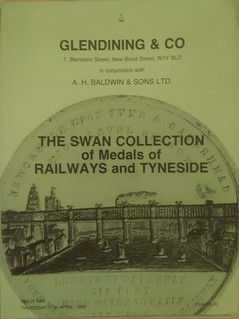 "A reader asked about books on Railway Medals. I
would suggest the Glendining auction catalogue of the Swan Collection of Medals of Railways 1986. It comprises over 400 lots of British and Foreign medals. It was a very extensive collection. It is
well illustrated and is crossed referenced to Moyaux."
"A reader asked about books on Railway Medals. I
would suggest the Glendining auction catalogue of the Swan Collection of Medals of Railways 1986. It comprises over 400 lots of British and Foreign medals. It was a very extensive collection. It is
well illustrated and is crossed referenced to Moyaux."
Thank you! -Editor
To read the earlier E-Sylum article, see:
NOTES FROM E-SYLUM READERS: MARCH 1, 2020 : Books on Railroad Medals (https://www.coinbooks.org/v23/esylum_v23n09a10.html)
The Walls Are Covered In Maps
Michael Marotta writes:
"This interview from Space.Com with the author of a new book of maps of the Earth and sky may strike some responsive chords with E-Sylum readers. The book is The Sky Atlas: The Greatest Maps, Myths and Discoveries of the Universe. Simon & Schuster (2019). The author is Edward Brooke-Hitchings. "
Thanks. Here's an excerpt Mike provided. -Editor
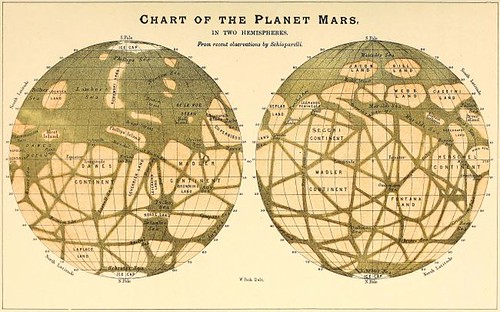
I grew up in a rare book shop. My dad is a rare book dealer, and rare book men, if there's any space with no shelves, the walls are covered in maps. And so my exposure to maps was not from knowing their history, but it was from getting a sort of osmosis effect of just their beauty and their intrigue. … In terms of research, I thought the best thing to do was not just go to public libraries, the British Library, the great institutions, because that's where everyone goes for their images and their stories. So I split it between going to museums and libraries, but also talking to a lot of dealers who have this magpie's eye for a great story, and they know how to sell you a map with just a few words. That's a very attractive sort of philosophy for writing books as well.
To read the complete article, see:
Star maps through the ages: A Q&A with the author of 'The Sky Atlas'
(https://www.space.com/sky-atlas-history-celestial-maps-book-interview.html)

FAKE NEWS: THE QUATLOO OF TRISKELION
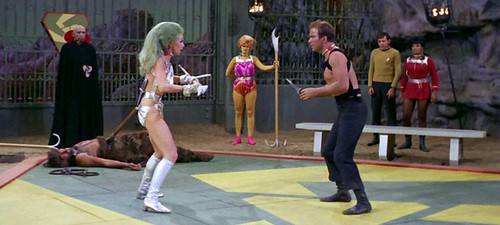
On the demonetization of the Quatloo of Triskelion, Tom DeLorey writes:
"The correspondence on the "Richmond Dollars" is interesting. I have never heard of any such thing, and I note that the quoted article refers to siege coins allegedly issued by General Gordon of Khartoum, which appear to be equally unknown to numismatists despite detailed knowledge of Gordon's siege currency.
"The publication cited as the source of the notice, Pearson's Weekly, was known in its time for publishing some notable fiction. Perhaps this was some of its lesser-known fiction. I remember during my time at Coin World when the publication made a brief but humorous mention of the Quatloo of Triskelion being demonetized. We received several letters (actual ink on dead trees) from Trekkies who got the joke. Margo was not amused.
"P.S.: I had nothing to do with the Quatloo filler being published, other than to encourage, along with David T. Alexander, the author of it to disregard his wiser second thoughts about letting it get into the paper."
A search on the Newman Numismatic Portal leads to a June 3, 2013 Coin World mention by David Alexander about the filler item (pg. 24). A web search turned up an undated article about the piece. Here's an excerpt - see the complete article online. -Editor
In this episode, the bridge crew of the USS Enterprise was captured by an alien race from the planet Triskelion and forced to participate in gladiator-style games while the audience bet on the outcome of each match in the planet’s unit of currency, the “quatloo.” Capt. James T. Kirk, for example, had to fight against a slave or “drill thrall” called Shahna, played by the actress Angelique Pettyjohn, who was dressed in the standard (and sexist) Star Trek style for a woman from an alien civilization (meaning as little clothing that the standards of the 1960s allowed on television). During the match, which was supposed to be to the death, wagers were called out in units of quatloos by the leaders of the planet. Kirk managed to defeat Shahna though he declined to kill her and helped in defeating the evil Providers, who ran the games.
The episode was not one of the series’ best but it was one of the few that had anything remotely like a money reference.
Many readers asked the same question. What the heck was a “quatloo” and where was “Triskelion”? The correspondents had never heard of the place nor the currency unit. A smaller number of Trekkies among the readership caught the reference and wrote, essentially, “Hey, cool reference.”
Eventually the letters came to the attention of the news editor and of Margo Russell, our editor. Margo thought it cute, but the news editor mildly admonished me. Somewhere in my files I still have a clipping of my quatloo filler.
Today, being older and wiser and more experienced, I can only look back at that time and ask myself, “What was I thinking?”
Still, I am not going to take any credit for introducing the concept of “fake news.” That kind of thing happened long before I was born.
To read the Coin World article, see:
Did you hear about the quatloos of Triskelion?
(https://www.coinworld.com/voices/gerald-tebben/did_you_hear_aboutt.html)
To read the earlier E-Sylum article, see:
THE 'RICHMOND DOLLARS' (https://www.coinbooks.org/v23/esylum_v23n09a26.html)
VOCABULARY TERM: JANVIER PANTOGRAPH
Dick Johnson submitted this entry from his Encyclopedia of Coin and Medal Terminology. Thanks! -Editor
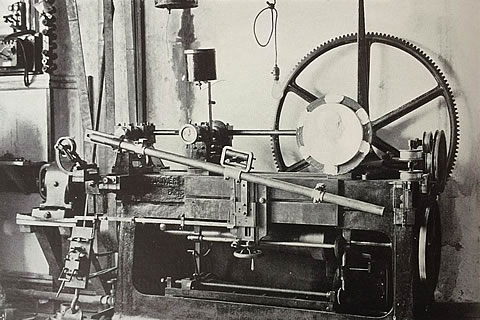
Janvier Reducing Machine
https://medalblog.wordpress.com/2010/12/27/janviers_pantograph/
Janvier Pantograph. A die-cutting machine, one of the most exacting and precise for reducing three-dimensional bas-relief designs while simultaneously cutting a die. The mechanical engraver is named after its developer, Victor Janvier (1852-1911), who did much to improve existing die-engraving machines, most notably the Contamin. He operated two separate businesses. One, Duval & Janvier, with sculptor Paul Marie Duval, did custom reductions, die-cutting and medal making (Janvier was an accomplished medalist himself since 1892). The other was Ateliers Victor Janvier, which constructed and sold reducing machines. After his death in 1911, the later firm became Janvier, Berchot & Cie.
Janvier's basic reducing machine was patented in 1899. In addition to two models of bas-relief reducing machines, the firm also crafted one for the reductions of small statues and sculpture in-the-round. Hundreds of Janvier's machines were sold throughout the world, primarily to coinage mints, medal makers, and tableware manufacturers. The name Janvier virtually became generic for these die-cutting machines.
Janvier's machines were so exacting and precise that an entire design – lettering, design and border elements– could be accomplished all at once (eliminating the need for reduction punches and lettering punched in the die separately). This accomplished a desired capability of the die-engraving pantograph that Matthew Boulton had conceived a century earlier (1797).
Both the Paris Mint and the London Mint obtained Janvier machines (1905). The Paris Mint had started a project to improve their die-engraving pantographs (1900), but after acquiring the Janvier they adopted for their own pantographs many of the innovations that Janvier had introduced. Even so they did not complete this project until 1927.
The usefulness of the Janvier was so extensive, however, it was widely employed even in the manufacture of small decorative objects other than coins and medals. In addition to table utensils this included: buttons, badges, emblems, jewelry and small machine parts.
The first Janvier was imported (1902) in the United States for what was to become the Medallic Art Company. The Philadelphia Mint purchased their first Janvier (1906), and Gorham & Company had four Janvier pantographs in their tableware design department in Providence by 1915. By the First World War over 20 Janvier pantographs had been sold in the United States alone, and, by 1921, 140 sold worldwide. See pantograph.
Looking for the meaning of a numismatic word, or the description of a term? Try the Newman Numismatic Portal's Numismatic Dictionary at: https://nnp.wustl.edu/library/dictionary
Or if you would like a printed copy of the complete Encyclopedia, it is available. There are 1,854 terms, on 678 pages, in The Encyclopedia of Coin and Medal Technology. Even running two a week would require more than 19 years to publish them all. If you would like an advance draft of this vital reference work it may be obtained from the author for your check of $50 sent postpaid. Dick Johnson, 139 Thompson Drive, Torrington, CT 06790.
HENRY C. KENDRICK (1828-1894)
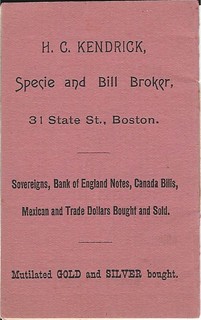 Henry C. Kendrick (1828-1894) was born in Bedford,
New Hampshire, son of Daniel and Laura Lombard Kendrick. On October 27, 1858 he married Elizabeth Whiting a native of Boston at Boston. They first moved to Charlestown, Middlesex County,
Massachusetts, where we find them listed in the 1860 U.S. Census. They moved to Hyde Park, Norfolk County, Massachusetts, listed in the 1870 U. S. Census. The Kendricks then moved to Quincy and lived
at 66 Franklin Street, also in Norfolk County, Massachusetts.
Henry C. Kendrick (1828-1894) was born in Bedford,
New Hampshire, son of Daniel and Laura Lombard Kendrick. On October 27, 1858 he married Elizabeth Whiting a native of Boston at Boston. They first moved to Charlestown, Middlesex County,
Massachusetts, where we find them listed in the 1860 U.S. Census. They moved to Hyde Park, Norfolk County, Massachusetts, listed in the 1870 U. S. Census. The Kendricks then moved to Quincy and lived
at 66 Franklin Street, also in Norfolk County, Massachusetts.
Kendrick was an entrepreneur, money & stock broker, revenue stamp, and specie broker in Boston active since the end of the Civil War. By 1865 he was selling Revenue Stamps or exchanged for torn or defaced currency and Greenbacks at the Traveller Counting Room on State Street. This was at the Boston Evening Traveller Building, which published a newspaper from 1845 until 1885. Among their tenants was Henry C. Kendrick listed as an American Bill Broker. In the 1870 Boston Directory he had a business partner, I. W. Elwell in the firm of Kendrick & Elwell, Fractional Currency & Bill Brokers, 31 State Street, Boston. In 1884, he was the proprietor of H. C. Kendrick's, 31 State Street, Boston, a Symphony Concert & Rehearsal Hall, where he sold seats, as well as his Specie & Bill Brokerage. In the 1888 Boston City Directory he is listed as a Specie Broker at 9 State Street, Boston. Circa 1890 he relocated to 15 State Street.
After his death the firm was renamed Kendrick's Money Exchange, and John P. Conroy was hired as the manager. By 1907 the firm relocated once again near the Easton Building, 9 State Street. The following year, 1908, the firm relocated this time to 218 Washington Street. By January 1910 the firm ran an advertising campaign in The Numismatist soliciting that they bought and sold rare coins.
To read the complete article, see:
KENDRICK, HENRY C.
(https://sites.google.com/site/numismaticmallcom/encyclopedic-dictionary-of-numismatic-biographies/kendrick-h-c)
To read an earlier E-Sylum article, see:
H. C. KENDRICK OF BOSTON: NO DEMAND FOR GOLD DOLLARS (https://www.coinbooks.org/esylum_v18n30a13.html)
MYSTERY COIN BOARD BINDER
In the Spring 2020 issue of his Coin Board News, author David Lange reported his recent purchase of this possibly unique coin board binder. He kindly forwarded the images for publishing here. Interesting item. BIN = "Buy it now". -Editor
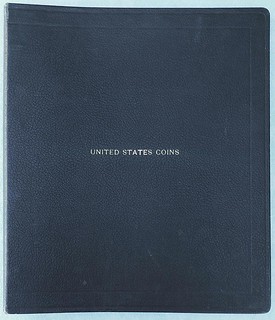 MYSTERY BINDER A couple months ago, while doing my daily
eBay searches, I spotted the item below that had just been listed. Though the BIN price seemed high, the old rule of “buy it when you see it, or you’ll never see it again” kicked in and made me bite.
It’s a large, heavyweight ring binder with a richly grained texture and the words UNITED STATES COINS printed on the front cover. Two common Whitman Second Edition boards dated 1938 are included,
these being punched four times each for mounting. The boards are in absolutely pristine condition, aside from one partially damaged opening in the cent board. It’s doubtful that this was a
Publisher-made product from Whitman, but it is clearly of the period and quite interesting.
MYSTERY BINDER A couple months ago, while doing my daily
eBay searches, I spotted the item below that had just been listed. Though the BIN price seemed high, the old rule of “buy it when you see it, or you’ll never see it again” kicked in and made me bite.
It’s a large, heavyweight ring binder with a richly grained texture and the words UNITED STATES COINS printed on the front cover. Two common Whitman Second Edition boards dated 1938 are included,
these being punched four times each for mounting. The boards are in absolutely pristine condition, aside from one partially damaged opening in the cent board. It’s doubtful that this was a
Publisher-made product from Whitman, but it is clearly of the period and quite interesting.
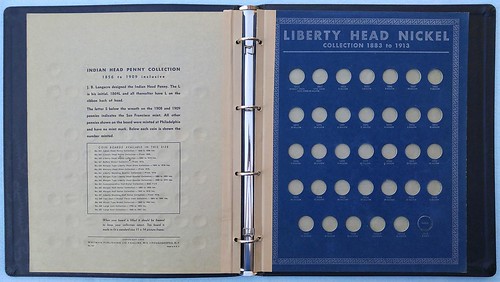
To visit Dave's Coin Collecting Boards web site, see:
https://www.coincollectingboards.com/
THE HEALTH OF THE HOBBY, 2020
Dennis Tucker of Whitman Publishing submitted this personal story on measuring the health of our hobby. Thanks! -Editor
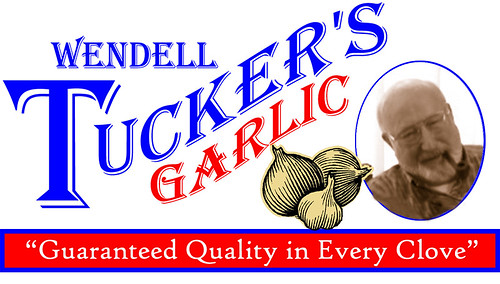
Gardening, like numismatics, can be both a hobby and a business.
For several years when I was a kid, my father and I would plant, nurture, and eventually harvest a big vegetable garden. It was something special he and I shared—my one older brother still living at home didn’t really take to it; my mother helped, but she focused mainly on her flower gardens. It was Dad and I who planned the vegetable garden, plotted its layout on graph paper late each winter or early in the spring, and did most of the work.
Now, umpteen years later, Dad still grows a garden each year. When we catch up by phone or in person, I get an update on how everything is doing—what’s growing well or poorly, what’s been affected by the weather, what’s seeing a good yield.
How do you measure the grassroots health of a hobby (like coin collecting)? I’ve always felt that the number, depth, and quality of books, magazines, and other products that serve a hobby make good measuring sticks. These are better gauges than just looking at auction records and top-end sale prices. It’s exciting that a 1938-S Mercury dime in MS- 68 recently sold for $364,250—even non-collectors are intrigued by such an event. But that’s only one numismatic transaction out of tens of thousands that occur every day.
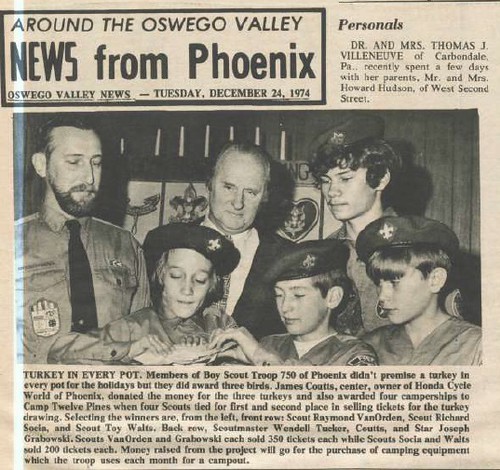
My father (left, as Scoutmaster of Boy Scout Troop 750, Phoenix, New York) in 1974. My brothers were all active in scouting, as I later would be.
Walk into a Barnes & Noble or Books-A-Million—the nation’s two largest bookstores— and you’ll see shelves full of hobby references and storage supplies. Those of us who collect coins, medals, tokens, paper money, and other numismatic treasures have a bumper crop to choose from these days.
The price of gold rises and falls, hot investments come and go, the United States Mint releases exciting new coins and medals that capture the popular imagination, market bubbles expand and pop. While all this is happening, the underlying health of the hobby—judging from the wealth of related “stuff” that helps collectors assemble, display, and enjoy their collections—is quite strong.
In the coming months you’ll continue to see a diverse library of books from Whitman Publishing in your local bookstores and hobby shops, and online. Charles Morgan and Hubert Walker have ranked the 100 Greatest Modern World Coins in a fascinating new study. Bill Bierly’s In God We Trust goes in-depth in a numismatic and historical exploration of the national motto. The year’s new Red Book, Blue Book, and Mega Red will be on bookshelves before you know it. A bit later in the year, we’ll have the latest volume of the Cherrypickers’ Guide, a new edition of Roger W. Burdette’s Guide Book of Peace Dollars, and many other books. Rumor has it the definitive autobiography of Q. David Bowers is in the offing! Postcard collectors will have a colorful new large-sized reference to enjoy. We’re working on new books in the world-coin arena, and also paper money, exonumia, and American colonials.
That’s not to mention what’s planned and in the works for 2021, 2022, and beyond.
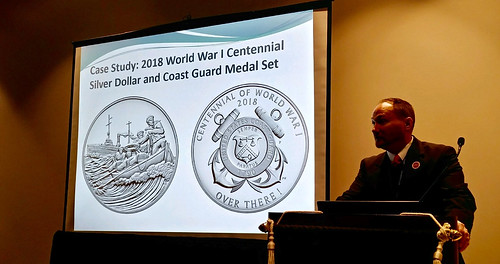
Dennis Tucker speaking at the American Numismatic Association National Money Show, February 27, 2020.
Albums and folders continue to be popular, from the classic blue Whitman folder to handsome leatherette albums. Coin maps, plastic tubes, 2x2-inch holders, display cases, and similar products give many options to the enthusiast. Whitman’s and other companies’ coin, paper currency, and stamp supplies offer excellent ways to showcase your collections.
Numismatics is alive and well. Keep an eye open and an ear to the ground as the hobby continues to grow and change. We’ll get the word out as new books and products become ready for you.

DAVISSON'S AUCTION 39 CLOSES APRIL 1, 2020
Davisson's Auction 39 closes Wednesday, April 1st, 2020. Allan Davisson penned the following thoughts in a February 29, 2020 email announcement. -Editor
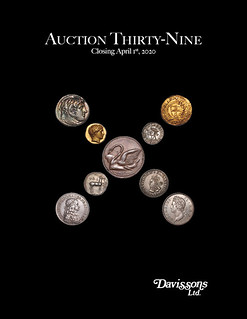 Our 39th major auction is a long way from our first such
sale in April of 1993. We began by noting “We have been publishing fixed price catalogs…for well over two decades. We are excited about assembling and publishing our first major bid sale.”
Our 39th major auction is a long way from our first such
sale in April of 1993. We began by noting “We have been publishing fixed price catalogs…for well over two decades. We are excited about assembling and publishing our first major bid sale.”
Well, we are still excited about our annual major sale. We start thinking about it a year in advance, seeking special items to feature. Our first auction catalog had well over 300 lots—gold coins (31 lots), Greek coins including a couple of rare staters from Crete, Roman Republican coins (23 lots), Roman through Ostrogothic, 122 English, Scottish and Irish coins, tokens, medals and a run of books. The photos were black-and-white at the end of the text.
This catalog is a strong successor to that early beginning. The photos are in color in the text. The mix is similar. The terms are little different. In 1993 we noted that “There is NO ten percent buyer’s fee.” The only change here is that hardly any auction firm now limits the buyer’s fee to ten percent.
Some thoughts on what we have found for this sale:
Gold coins in this sale range from ancient Greek, Roman, Byzantine, and Celtic to hammered English to an early 19th century US rarity–affordable pieces that would make handsome additions to a collection. We put back some hammered English gold coins for this sale, enabling us to offer better quality pieces at a time of strong prices for high quality hammered gold.
The ancient Greek and Roman sections are representative of the broad and exciting world of ancient coins. Look for some exceptional tetradrachms, and many rare and special coins throughout. We had an old collection of ancient coins to pick from and the rarity and quality are exceptional, the estimates modest.
In addition to high quality British hammered coins, some exceptional foreign crowns, and a small group of Colonial and early American coins, two areas deserve special mention:
• The Frank Robinson Collection: In this sale we begin his collection of crowns—an exceptional run of high quality pieces. A “good Extremely Fine” crown with attractive old toning is a very satisfying piece to have in a collection. The pieces that particularly amazed me are the coins in the specimen and proof sets. To find complete sets with choice coins throughout is highly unusual. These sets are as fine or finer than any I have seen and when I talked with Frank about them he commented about how careful he had been in acquiring them.
• The Mike Sussman Collection of British Tokens is a strong sampling of some of the best and scarcest tokens in his nearly 500 piece collection. He formed the collection over the past few years picking up material from such major sales as the Baldwin Basement Sale series. He sought the best possible quality and was willing in many cases to pay a premium. The estimates are conservative and many of the rarities are pieces you seldom see. (We offered his Pidcock tokens in an earlier sale and one of the pieces sold was an RRR piece that Waters reported as “not traced.”) For all the years I have worked with tokens I was surprised myself to see a few pieces I had not seen before and that were even lacking in the massive 1998 Noble sale.
When I look back at our old catalogs I see things that I will not see again. Some coins are available almost anytime if you are willing to pay the price. Some things are here now but may well end up gone for generations. Some of what we offer fits in this latter category. Each of our sales has had items that I now realize were a fleeting opportunity.
Thank you for your ongoing interest and support. I hope you enjoy this sale.
To browse the catalog, see:
https://davcoin.com/sale/Printed%20Auction%2039
NUMISMAGRAM MEDAL SELECTIONS: MARCH 2020
Jeremy Bostwick at Numismagram forwarded along these highlights from his most recent March upload of exonumia. In addition to the pieces below, this assortment includes a few other World War I related issues, a Franco-American 'Sinking of the Lusitania' medal, a gold love token with a musical twist, a lustrous and vibrant British award medal in the field of cooking, a couple types sure to delight any animal lover, and a stunning French railroad jeton, among others. Please visit numismagram.com/inventory for more. -Editor
Feminine Virtue Silver Medal
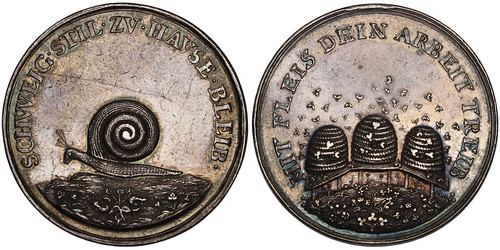
100936 | GERMANY. Feminine Virtue silver Medal. Issued circa late 18th/early 19th century (38mm, 18.41 g, 12h). Possibly after C. Sucro. SCHWEIG STIL ZV HAVSE BLEIB (Peace will be had at home...), snail (representing tranquility) advancing left; flower below / MIT FLEIS DEIN ARBEIT TREIB (...with attention to one's domestic chores), three beehives, with bees (representing industriousness) swarming around. Edge: Plain. GPH –. Choice Very Fine. Lightly toned, with some darker hues near the peripheries; some central brilliance, though a number of marks are noted, as well as some light scratches around the snail. A highly interesting and very rare topical medal relating to domesticity. $575.
A rather stark reminder of the patriarchal society in which it was produced, this medal conveys the feminine virtue that is subservience and domesticity. Mainly, that a wife should remain industrious around the home with her chores in order to ensure domestic bliss and tranquility within the household. It would be nice to believe that we have progressed beyond this archaic establishment of gender roles and of the patriarchy, but one need not look far to see the inequalities that still exist in this area—as well as many others.
What an odd item. I don't recall seeing a snail on a medal before. Beehives are popular. Snails? Not so much. -Editor
To read the complete item description, see:
100936 | GERMANY. Feminine Virtue silver Medal. (https://www.numismagram.com/product-page/100936)
Munich Firefighter's Silver Award Medal
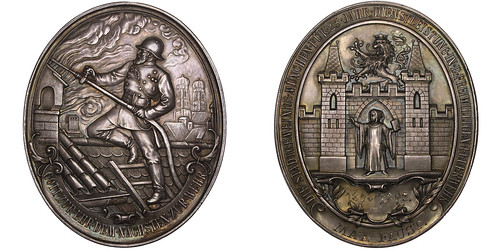
101020 | GERMANY. Firefighter's oval silver Award Medal. Engraved 1893 and awarded to Max Faust for 25 years of service with the München (Munich) Firefighters (67x82mm, 150.69 g, 12h). By F. Widmann & L. Leigh. GOTT ZUR EHR DEM NÄCHSTEN ZUR WEHR (to the glory of God, to the defense of our neighbors), firefighter standing left at the top of ladder, operating hose and attempting to extinguish an inferno raging at the roof of building; cityscape in background / DIE STADTGEMEINDE MÜNCHEN FÜR 25 JÄHR DIENSTLEISTUNG IN D FREIWILLIGEN FEUERWEHR (for 25 years of service to the municipality of Munich as a volunteer firefighter), civic coat-of-arms of München; below, two decorative scrolls inscribed “1868–1893” and “MAX FAUST.” Edge: A few light marks, otherwise plain. Hauser 719. Choice Mint State. Pleasing gray surfaces with an alluring iridescence highlighting the devices. $1,095.
Founded on 20 January 1891, this award was meant for volunteer members of the fire brigade in München following their 25 years of service. As such, Max Faust was one of the earlier recipients of the award, having served as a firefighter since before the Franco-Prussian War and the unification of Germany. A great representation of late 19th century firefighting attire and equipment.
The oval shape is unusual for a medal. Very cool. -Editor
To read the complete item description, see:
101020 | GERMANY. Firefighter's oval silver Award Medal. (https://www.numismagram.com/product-page/101020)
Destruction of the Zeppelin Gold Award Medal
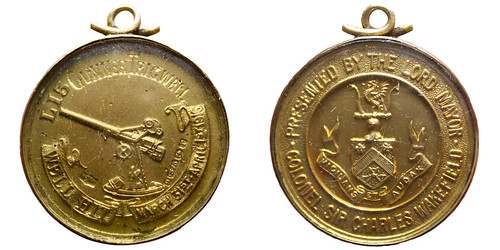
101019 | GREAT BRITAIN & GERMANY. Destruction of the Zeppelin gold Award Medal. Issued 1916. Engraved and awarded to Gunner Trigwell for successfully downing a German Zeppelin (30mm, 13.42 g, 12h). By Mappin & Webb in Birmingham. GUNNER TRIGWELL, anti-aircraft gun left, being manned by a gunner, with barrel pointed toward "L15" representing the Zeppelin airships; below, banner reading WELL HIT MARCH 31st–APRIL 1st 1916 / PRESENTED BY THE LORD MAYOR / COLONEL SIR CHARLES WAKEFIELD, familial coat-of-arms of Wakefield. BHM –; Eimer –; Jones, Dance of Death, –; The Art of Devastation –; Barac –. Gem Mint State. Charming bronze-gold glazed surfaces, with some underlying brilliance and some light deposits from being in the original lunettes; clasp at the top. Very rare and interesting type. $975.
Zeppelin was a German general and aircraft manufacturer, who later founded the airship company Luftschiffbau Zeppelin. During World War I, many of his airships were utilized in scouting missions and bombing campaigns, most notably in Britain where their bombings killed over 500 citizens. Following some of these raids, Colonel Sir Charles Cheers Wakefield—founder of the Castrol motor oil and lubricants company and also the Lord Mayor of London—offered a £500 prize to whoever shot down the first of these enemy airships. On the night of 31 March and into the following morning, a zeppelin raid ensued, and a Royal Artillery battery at Purfleet successfully hit and brought down an airship. As the War Office ruled that soldiers could not receive such compensation in the form of a monetary prize, Wakefield instead commissioned some 353 of these medals—struck in 9 carat gold—to be produced, engraved, and presented to gunners at the battery in honor of addressing the zeppelin threat.
I was unaware of these medals - a great item. -Editor
To read the complete item description, see:
101019 | GREAT BRITAIN & GERMANY. Destruction of a Zeppelin gold Award Medal. (https://www.numismagram.com/product-page/101019)
Hawai'i. Kalakaua Aluminum Dala Trial Strike
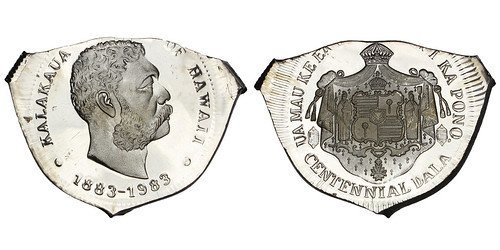
101056 | UNITED STATES. Hawai'i. Kalakaua Aluminum Centennial Dala Trial Strike. Issued 1982. (45x34mm, 12.09 g, 12h). Hawaiian Mint. KALAKAUA [I KING] OF HAWAII, bare head right / UA MAU KE EA O [KA AINA] I KA PONO / CENTENNIAL DALA, crowned and mantled coat-of-arms. Cf. KM (X) MB6 (for regular silver issue). Choice Mint State. Extremely lustrous and prooflike; a few scattered marks and hairlines. Interesting pre-production trial used in the aligning of the dies. $295.
In honor of the 100th anniversary of the series of denominations struck in the name of King Kalakaua in 1883, the Hawaiian Mint struck a centennial ‘dala’ featuring a reprisal of the original design (with some slight modifications) and to the weight of one ounce of silver. Striking began for this commemorative output late in 1982, with 10,000 in total being produced. Before the initial early strikes were coined, however, the mint appears to have had a bit of fun while aligning the dies, striking a few random strips of aluminum with the design—accounting for this unusual, irregular, off-metal trial strike.
In 1974 Bernard von NotHaus and Talena (Telle) Jay Presley started The NotHaus Mint, which grew to become The Hawaiian Mint and was renamed the Royal Hawaiian Mint in 1986. Von Nothaus later created the Liberty Dollar and the National Organization for the Repeal of the Federal Reserve and Internal Revenue Code (NORFED). -Editor
To read the complete item description, see:
101056 | UNITED STATES. Hawai'i. Kalakaua Aluminum Dala Trial Strike. (https://www.numismagram.com/product-page/101056)
Zdenek Michael František Burian Silver Medal
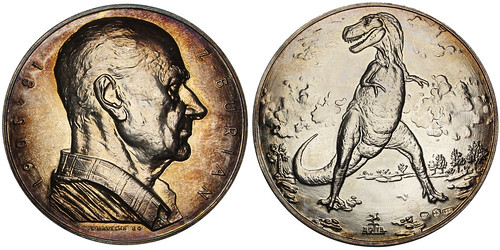
100983 | CZECHOSLOVAKIA. Zdenek Michael František Burian silver Medal. Issued 1984. Commemorating the Life of the Famous Painter, Illustrator, and Palaeoartist (40mm, 31.69 g, 12h). By L. Havelka. 1905 + 81 Z • BURIAN, bare head right / Tyrannosaurus Rex advancing right, head left. Edge: Plain. Choice Mint State. Highly lustrous with some golden-russet toning more noticeable on the obverse; a few light hairlines are mentioned merely for completeness. $295.
Born in 1905 in the Austro-Hungarian Empire, Zdenek Burian would come to play an important role in the development of palaeontological art and reconstruction. Through the government run Czechoslovakian publishing house, Artia, his work, especially on dinosaurs, reached a western audience beginning in the 1950's and 1960's, and offered a vivid, lifelike picture into the prehistoric world. It's hard to imagine the dinosaur "craze" of the 1980's and 1990's without him.
As a 1960s kid I carried around a big plastic disosaur for a long time. Dinos were definitely the "in" thing. -Editor
To read the complete item description, see:
100983 | CZECHOSLOVAKIA. Zdenek Michael František Burian silver Medal (https://www.numismagram.com/product-page/100983)
STACK'S BOWERS OFFERS BERG-GARRETT 1804 DOLLAR
Stack's Bowers Galleries published this press release about their upcoming sale of the Berg-Garrett 1804 Dollar. -Editor
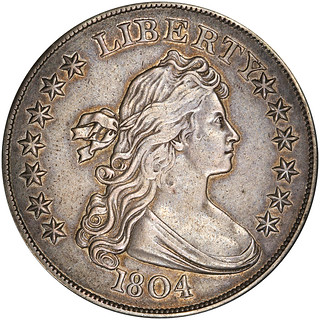
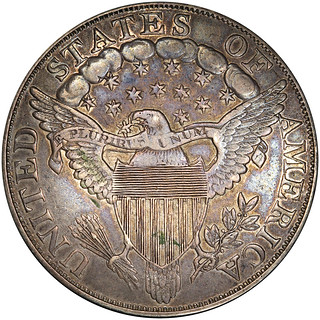
A rare 1804 silver dollar, the most famous prize in coin collecting, will be sold in Baltimore on March 20, at an auction conducted by Stack’s Bowers Galleries of Santa Ana, California. One of just 15 known to exist, the auction house expects the coin to bring between $1.2 and $1.5 million. When it was auctioned on behalf of Johns Hopkins University in 1980, it became the most valuable silver coin in the world. It was acquired by JHU by bequest from the Garrett Family, who first bought the coin in 1883.
Though dated 1804, the Garrett specimen of this renowned rarity was struck in secret at the Philadelphia Mint sometime between the 1850s and early 1870s, as coin collectors realized how rare 1804-dated silver dollars were and the U.S. Mint sought to cash in. The original 1804 dollars were struck in 1834, intended as diplomatic gifts to Asian monarchs, produced as part of special presentation sets of American coins. Due to a misunderstanding of mint records, which indicated that the last silver dollars were struck in 1804, American government officials produced new silver dollars with the 1804 date. The last silver dollars before 1834 were coined in 1804 but bore the date 1803.
As American coin collectors realized how rare 1804-dated silver dollars were, they became legendary trophies in the world of numismatics, setting new price records at each auction. T. Harrison Garrett, the Baltimore railroad magnate who was one of the leading coin collectors in America before his death in 1888, acquired the coin in a Philadelphia auction in 1883. The Garrett Collection was given to JHU in 1942, then sold in a series of auctions from 1976 to 1981 by the predecessor firms of Stack’s Bowers Galleries.
“The 1804 dollar is known as the King of American Coins for good reason,” said Brian Kendrella, president of Stack’s Bowers Galleries. “We’ve been fortunate to sell nearly every privately-owned specimen since our firm’s founding in 1935. Every time one crosses the auction block it makes for a headline-grabbing event.”
Here's the coin's pedigree chain from the lot description. -Editor
The Berg Specimen. 1859-1872: Believed to have been struck at the Philadelphia Mint during this time period. Ex Captain John W. Haseltine, 1875-1876, who displayed the coin at Edward Cogan's Jewett Sale, January 1876; O.H. Berg, 1876-circa 1883; J.W. Haseltine's sale of the Berg Collection, May 23-24, 1883, lot 568; George W. Cogan, agent for Thomas Harrison Garrett, 1883; T. Harrison Garrett, 1883-1888; Robert and John Work Garrett, by descent, 1888; Robert Garrett interest to John Work Garrett, 1919, transfer completed 1921; John Work Garrett, 1919-1942; The Johns Hopkins University, 1942-1980; our (Bowers and Ruddy's) sale of the Garrett Collection for the Johns Hopkins University, Part II, March 1980, lot 698; Pullen & Hanks (William Pullen and Larry Hanks), later in combination with Santa ("Sam") Colavita; Sam Colavita, 1980-1982, who purchased the interest of Pullen & Hanks on April 17, 1980; offered for sale through Texas dealer Ed Hipps; Pullen & Hanks' Long Beach Collector Series I Sale, February 1982, lot 1076, unsold; Sam Colavita, 1982, but continued on consignment with Pullen & Hanks, who in the same year transmitted it by private treaty to the following; Mike Levinson, acquired in trade for eight acres of land in El Paso, Texas, 1982-1984; Pennsylvania private collection, 1984-1986; our (Bowers and Merena's) Harry Einstein Collection sale, June 1986, lot 1736; Rarities Group, Inc. (Martin B. Paul), 1986; American Coin Portfolios (Dan Drykerman), November 1986, agent for the following; Mrs. Laura Sommer; private Southern California collector; our Chicago ANA Auction of August 2014, lot 13146; D. Brent Pogue. 402.8 grains. Edge lettering blundered and doubled in areas. Double struck on reverse. Reverse slightly rotated (0 in date is aligned with the second T in STATES). The present example.
To read the complete lot description, see:
1804 Draped Bust Silver Dollar. Class III Restrike.
BB-306. Second Reverse. Proof-55 (PCGS). (https://auctions.stacksbowers.com/lots/view/3-LYACG/1804-draped-bust-silver-dollar-class-iii-restrike-bb-306-second-reverse-proof-55-pcgs)
1865 SERIAL NUMBER 1 NATIONAL BANK NOTE SHEET
Some great U.S. banknote rarities have surfaced - here's an except from an article published by grading firm PMG. -Editor
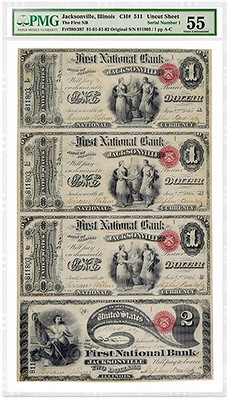
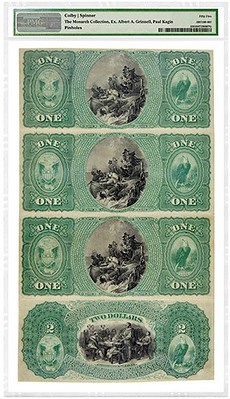
Paper Money Guaranty® (PMG®) recently certified a group of seven of the greatest uncut sheets of US banknotes in existence. The seven sheets highlight the Monarch Collection, a phenomenal collection of US paper money carefully curated by a collector decades ago, before the advent of paper money certification.
The centerpiece of the Monarch Collection is the “Holy Grail” of uncut National Bank Notes: a sheet of four Serial Number 1 notes from the First Charter of National Bank Notes issued starting in 1865. The famed Serial Number 1 sheet, the only First Charter Serial Number 1 sheet known, is graded PMG 55 About Uncirculated and pedigreed to the Grinnell Collection, which was the most prestigious assemblage of US paper money at the time of its sale in the 1940s.
The Monarch Collection also includes five uncut sheets with an extraordinary provenance traced to 1923, when they were set aside by special request for Register of the Treasury Harley V. Speelman, whose signature appears on the notes. This quintet features uncut sheets of two of the most iconic US notes: the $10 Bison and the $5 Chief.
The final sheet in the Monarch Collection is a unique 1896 Educational Series $1 sheet. Its design is considered to be one of the most beautiful in all of US paper money.
Banknotes are printed in sheets, which are then cut into individual notes for circulation. Uncut sheets of Large Size banknotes, which were issued from 1861 to 1928, were almost unobtainable at the time, making them extremely rare—and highly sought after—today. Together, the group of seven uncut sheets in the Monarch Collection represents some of the most important treasures from the Large Size era of US banknotes.
The incredible 1865 Serial Number 1 National Bank Note sheet was part of the original series of National Bank Notes authorized by the federal government amid currency pressures during and after the Civil War. Issued by the First National Bank of Jacksonville, Illinois – a city just west of the capital of Springfield – it features three $1 notes and one $2 note.
To read the complete article, see:
PMG Certifies the ‘Holy Grail’ of Uncut Currency
(https://www.pmgnotes.com/news/article/8156/monarch-collection-uncut-sheets-vintage-banknotes/)
YEMEN'S RIVAL BANKNOTES
JP Koning writes:
"Here are some interesting stories about Yemen riyal banknotes. Apparently the Yemeni central bank has split into two. One of the central bank branches has issued new notes, but the other won't accept them. As a result, an exchange rate has emerged between old and new Yemen riyal notes."
Thanks. I'd seen some articles about the situation, but don't think we've mentioned it yet in The E-Sylum. -Editor
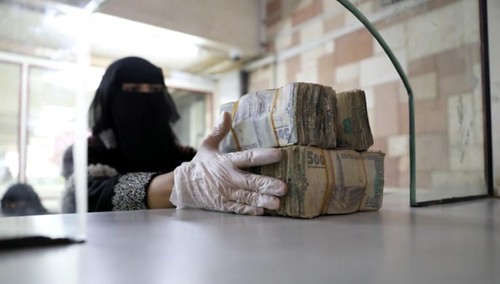
An employee takes bundles of Yemeni Riyal at the Central Bank of Yemen in Sanaa
Yemen’s warring sides opened a new front in their five-year conflict on Saturday - a battle over old and new banknotes that threatens to create two economies in the same state.
As of midnight, the Houthi movement which controls the capital Sanaa outlawed the use and possession of crisp new Yemeni riyal bills issued by its rivals in the internationally recognized government based in the southern port town of Aden.
The Iran-allied Houthis, who say people should only use the old bills, have defended the ban as a move against inflation and what they call rampant money-printing by the government.
The government has branded the ban an act of economic vandalism. And the population, as ever, have been left stuck in the crossfire.
To read the complete article, see:
Yemen's rival powers battle over banknotes
(https://www.reuters.com/article/us-yemen-economy-currency/yemens-rival-powers-battle-over-banknotes-idUSKBN1ZH034)
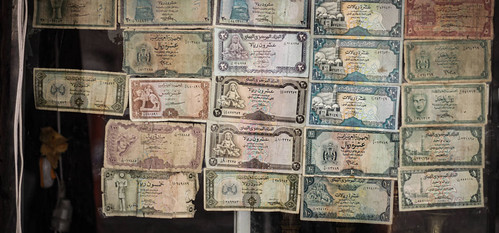
Old Yemeni rial banknotes on display in a shop window
From the internationally recognized Yemeni government’s interim capital of Aden, the central bank’s relocated headquarters has kept the institution’s international recognition, allowing it to, among other things, print currency and access international financial markets. Meanwhile, the central bank’s historic home in the capital, Sana’a, controlled by the Houthi group, has maintained its purview over the country’s largest consumer markets and financial centers.
The battle between the central banks entered a dangerous new phase on December 18, 2019, when the Sana’a branch banned newly-printed currency bills issued by its Aden rival and gave residents of Houthi-held areas a one-month window to trade in the “illegal” bills for either old ones – issued pre-September 2016 – or a new electronic currency the Houthi authorities are trying to implement. Turmoil has ensued.
This paper traces the beginnings of Yemen’s currency war and how monetary policy became fractured across frontlines. It examines the impacts of divided monetary supply management, as well as Houthi attempts to undermine Aden central bank policies and keep the country’s financial markets tethered to Sana’a. The Houthi decree in December 2019 marked a clear escalation in the currency war; this paper details the new banknote ban, how its enforcement has varied by region, as well as the e-Rial and its likely terminal flaws.
Market reaction to the banknote ban has seen flourishing black market currency trading, currency smuggling across frontlines, and the emergence of increasingly divergent exchange rates around the country as new rial banknotes have flooded back to government areas. In institutionalizing two monetary systems the Houthi move has had the political effect of furthering the emergence of distinct statelets within Yemen’s borders.
To read the complete article, see:
Yemen Economic Bulletin: The War for Monetary Control Enters a Dangerous New Phase
(https://sanaacenter.org/publications/analysis/8674)
BANKNOTE HANDLERS CORONAVIRUS CAUTIONS
Ron Guth passed along this item about banknotes as potential carriers of disease. -Editor
The infectious COVID-19 virus could be carried on the surface of banknotes for many weeks, the WHO warned on Monday.
Payments should be used by individuals where possible and clean their hands after handling cash to halt the spread of this disease, a WHO spokesman said.
The Bank of England also recognized that banknotes ”can carry viruses or germs” and encouraged regular hand washing.
A Bank of England spokesman told the Telegraph:”Like any other surface that large quantities of individuals come in contact with, notes can carry bacteria or viruses.
To read the complete article, see:
Banknotes Could be spreading coronavirus
(https://coronavirus-map.com/usa-coronavirus/banknotes-could-be-spreading-coronavirus/)
But the risk is small. Here's another take, from The Guardian. -Editor
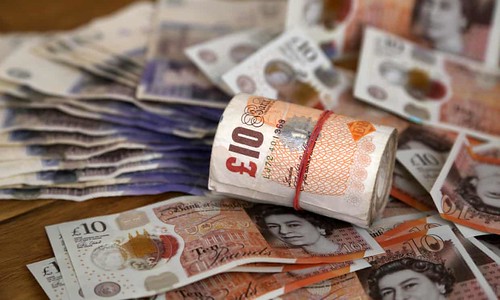
As public health officials around the world battle to contain the spread of coronavirus, the World Health Organization has warned that banknotes may transmit the disease. “We know that money changes hands frequently and can pick up all sorts of bacteria and viruses,” a WHO spokesman told the Telegraph. “We would advise people to wash their hands after handling banknotes, and avoid touching their face.” The spokesman also advises using contactless payment options wherever possible, to minimise the risk.
Although coronavirus can be transmitted via inanimate objects, the odds of contracting it in this way are low. “The amount of virus that is potentially on an inanimate object is usually very small,” says Dr Christine Tait-Burkard, an expert in infection and immunity at the Roslin Institute at the University of Edinburgh. She explains that there typically wouldn’t be much coronavirus on a person’s fingertips, and it would still have to get past your respiratory system to infect you. “Your respiratory system is very good at filtering out viruses,” Tait-Burkard says.
Banknotes can carry the coronavirus. But try not to be too alarmed: the risk is small. “Unless someone is using a bank note to sneeze in,” Tait-Burkard says. Don’t worry too much about loose change. “Coins are actually very bad environments for viruses to survive,” she says.
To read the complete article, see:
From banknotes to handrails: 10 objects that help spread
coronavirus (https://www.theguardian.com/world/shortcuts/2020/mar/03/from-banknotes-to-handrails-10-objects-that-help-spread-coronavirus)
The Federal Reserve is taking new precautions against banknotes from overseas. -Editor
The greenback faces the same fate as many travelers returning home from China and other coronavirus hot spots.
The US Federal Reserve has begun quarantining physical dollars that it repatriates from Asia before recirculating them in the US financial system as a precautionary measure against spreading the virus, a Fed spokesperson told Reuters.
She said regional Fed banks that help manage the money supply will set aside shipments of dollars from Asia for seven to 10 days before processing and redistributing them to financial institutions. The policy, first reported by Reuters, was implemented on Feb. 21, the official said.
As the global reserve currency, US dollars are the most widely distributed notes in the world with around $1.75 trillion worth of cash in circulation globally, according to the Fed. Much of that is circulated overseas, particularly in Asia, where the dollar is often stronger than local currencies.
The US central bank has not gone as far as its counterparts in China and Korea, which have ordered local currency notes to be disinfected with ultraviolet light or destroyed altogether. But Fed officials are in regular contact with the CDC and State Department regarding the spread of the virus and are prepared to add other regions to its quarantine list, the spokesperson said.
To read the complete article, see:
Fed is quarantining physical dollars from China
(https://nypost.com/2020/03/06/fed-is-quarantining-physical-dollars-from-china/)
ARTIST ANDREY AVGUST REIMAGINES U.S. BANKNOTES
Robert Laviana passed along a link to a U.S. banknote redesign project by artist Andrey Avgust. Thanks! I'm not sure if we've covered this before. I located an article from June 2018 with some more information. -Editor
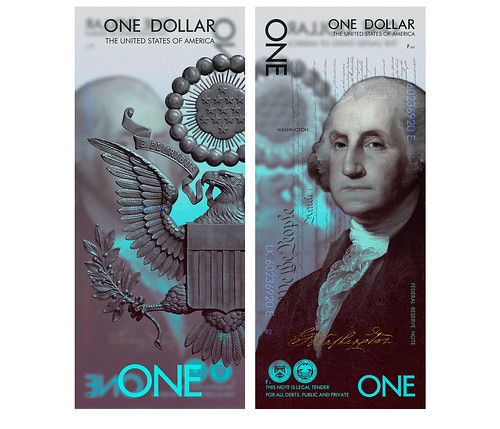
Belarusian designer Andrey Avgust has turned American banknotes 90 degrees and created graphics for the new format, in this conceptual take on the country's currency.
Avgust's project sees the country's one, five, 10, 20, 50, and 100 dollar bills imagined as boldly coloured polymer banknotes.
The New US Dollars series would be made up of translucent layers of flexible plastic, making them more hardwearing than the current cotton-fibre paper notes, like the new £5 and £10 notes for England.
They are also intended to bolster the currency's security and make it more difficult to counterfeit. Visuals show a random assortment of numbers and letters glowing across their surfaces in the dark.
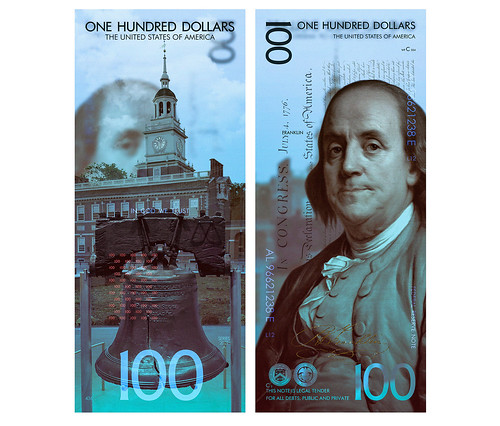
With the orientation flipped from horizontal to a vertical, Avgust's contemporary alternative also follows the recent redesigns for Canada's $10 bill and Northern Ireland's banknotes.
This switch offered the designer the opportunity to create new visuals to replace the current green-hued imagery.
His suggested alternative is a set of muted blue- and grey-coloured notes, which accompany monochrome portraits of historical American figures.
These are some stunning designs. Follow the links for more. -Editor
To read the complete articles, see:
THE NEW US DOLLAR (https://www.behance.net/gallery/63326431/THE-NEW-US-DOLLAR)
Andrey Avgust reimagines US dollar bills as vertical designs
(https://www.dezeen.com/2018/06/19/andrey-avgust-reimagines-us-dollar-bills-vertical-illustrated-designs/)
FEATURED WEB SITE: ROYAL HAWAIIAN MINT
This week's Featured Web Site is the Royal Hawaiian Mint.As "Hawaii’s own mint" the Royal Hawaiian Mint has been involved with many diverse causes, projects and commemorated a wide variety of occasions from a Surfing Santa on a Christmas Dala to Aloha Money counter stamped on US coins, the annual Aloha Festivals, the Akahi Dala, Aloha Dala, Honolulu Dala, Waikiki Dala and an unusual Christmas coin ornament. Many of the Contemporary Issues were issued as part of an organization celebrating its event.

https://www.royalhawaiianmint.com/

